When your audiologist diagnoses you with hearing loss, they will identify it as sensorineural (inner ear), conductive (outer and middle ear) or mixed (a combination of both). The type of hearing loss and its cause will determine the best treatment approach. Let’s explore conductive hearing loss, its common causes and how hearing aids can effectively manage permanent cases.
Common Causes of Conductive Hearing Loss

Conductive hearing loss happens when sound waves cannot pass through the outer or middle ear to the inner ear. A few reasons this blockage may arise include:
- Ear infection. Ear infections occur when a virus or bacteria infects the space behind the eardrum, causing inflammation and fluid buildup, which may block the passage of sound.
- Earwax blockage. While most wax moves out of the ear naturally, excessive production can block the ear canal, preventing sound waves from passing through.
- Otosclerosis. Bone remodeling is a continuous process in which new bone tissue replaces old. In cases of otosclerosis, the new bone grows abnormally, interfering with sound’s ability to travel through the ear.
- Perforated eardrum. A perforated or ruptured eardrum is a hole or tear in your eardrum. This tear can leave the ear vulnerable to infection and prevent the proper transmission of sound waves.
- Object in the ear. Children love to stick small objects in their ears. Whether it’s a pebble from the Balboa Park Playground or their peas from dinner, these tiny objects can get lodged in the ear canal, blocking the sound path.
Other potential causes of conductive hearing loss include swimmer’s ear, Eustachian tube dysfunction, benign tumors, physical trauma and outer or middle ear malformation.
Managing Conductive Hearing Loss
Many cases of conductive hearing loss are temporary and will resolve once the infection, damage or blockage has resolved. To help safeguard your hearing, schedule an appointment with your ENT at the onset of symptoms for prompt treatment.
If your hearing loss is permanent, hearing aids can significantly improve your quality of life. These small but powerful devices collect, amplify and carry sounds from your environment directly to your ears. By doing so, they provide clearer communication, increased social confidence and better background awareness to help reduce the impact of hearing loss on your daily life.
Whatever the cause, you don’t need to handle your hearing loss alone. Contact San Diego ENT today to schedule an exam and treatment consultation with one of our qualified specialists.
